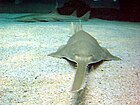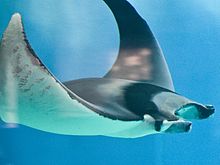
A | B | C | D | E | F | G | H | CH | I | J | K | L | M | N | O | P | Q | R | S | T | U | V | W | X | Y | Z | 0 | 1 | 2 | 3 | 4 | 5 | 6 | 7 | 8 | 9
| Batoidea Temporal range: [1]
| |
|---|---|

| |
| Common stingray, Dasyatis pastinaca | |
| Scientific classification | |
| Domain: | Eukaryota |
| Kingdom: | Animalia |
| Phylum: | Chordata |
| Class: | Chondrichthyes |
| Subclass: | Elasmobranchii |
| Clade: | Neoselachii |
| Superorder: | Batoidea Compagno, 1973 |
| Orders | |
| Synonyms | |
| |

Batoidea is a superorder of cartilaginous fishes, commonly known as rays. They and their close relatives, the sharks, comprise the subclass Elasmobranchii. Rays are the largest group of cartilaginous fishes, with well over 600 species in 26 families. Rays are distinguished by their flattened bodies, enlarged pectoral fins that are fused to the head, and gill slits that are placed on their ventral surfaces.
Anatomy
Batoids are flat-bodied, and, like sharks, are cartilaginous fish, meaning they have a boneless skeleton made of a tough, elastic cartilage. Most batoids have five ventral slot-like body openings called gill slits that lead from the gills, but the Hexatrygonidae have six.[2] Batoid gill slits lie under the pectoral fins on the underside, whereas a shark's are on the sides of the head. Most batoids have a flat, disk-like body, with the exception of the guitarfishes and sawfishes, while most sharks have a spindle-shaped body. Many species of batoid have developed their pectoral fins into broad flat wing-like appendages. The anal fin is absent. The eyes and spiracles are located on top of the head. Batoids have a ventrally located mouth and can considerably protrude their upper jaw (palatoquadrate cartilage) away from the cranium to capture prey.[3] The jaws have euhyostylic type suspension, which relies completely on the hyomandibular cartilages for support.[4] Bottom-dwelling batoids breathe by taking water in through the spiracles, rather than through the mouth as most fish do, and passing it outward through the gills.
Reproduction
Batoids reproduce in a number of ways. As is characteristic of elasmobranchs, batoids undergo internal fertilization. Internal fertilization is advantageous to batoids as it conserves sperm, does not expose eggs to consumption by predators, and ensures that all the energy involved in reproduction is retained and not lost to the environment.[5] All skates and some rays are oviparous (egg laying) while other rays are ovoviviparous, meaning that they give birth to young which develop in a womb but without involvement of a placenta.[6]
The eggs of oviparous skates are laid in leathery egg cases that are commonly known as mermaid's purses and which often wash up empty on beaches in areas where skates are common.
Capture-induced premature birth and abortion (collectively called capture-induced parturition) occurs frequently in sharks and rays when fished.[6] Capture-induced parturition is rarely considered in fisheries management despite being shown to occur in at least 12% of live bearing sharks and rays (88 species to date).[6]
Habitat
Most species live on the sea floor, in a variety of geographical regions – mainly in coastal waters, although some live in deep waters to at least 3,000 metres (9,800 ft). Most batoids have a cosmopolitan distribution, preferring tropical and subtropical marine environments, although there are temperate and cold-water species. Only a few species, like manta rays, live in the open sea, and only a few live in freshwater, while some batoids can live in brackish bays and estuaries.
Feeding
Most batoids have developed heavy, rounded teeth for crushing the shells of bottom-dwelling species such as snails, clams, oysters, crustaceans, and some fish, depending on the species. Manta rays feed on plankton.
Evolution
Batoids belong to the ancient lineage of cartilaginous fishes. Fossil denticles (tooth-like scales in the skin) resembling those of today's chondrichthyans date at least as far back as the Ordovician, with the oldest unambiguous fossils of cartilaginous fish dating from the middle Devonian. A clade within this diverse family, the Neoselachii, emerged by the Triassic, with the best-understood neoselachian fossils dating from the Jurassic. The oldest confirmed ray is Antiquaobatis, from the Pliensbachian of Germany.[7] The clade is represented today by sharks, sawfish, rays and skates.[8]
Classification
Molecular evidence refutes the hypothesis that skates and rays are derived sharks.[9] The monophyly of the skates, the stingrays, and the electric rays has long been generally accepted. Along with Rhinopristiformes, these comprise the four traditionally accepted major batoid lineages, as in Nelson's 2006 Fishes of the World. However, the exact phylogeny of the major batoid lineages, internally and with respect to one another, has been subject to diverse treatments. The following cladogram is based on a comprehensive morphological assessment of batoid phylogeny published in 2004:[10]
| Chondrichthyes |
| ||||||||||||
However, a 2011 study significantly reevaluated the phylogeny of batoids, using nuclear and mitochondrial DNA from 37 taxa, representing almost all recognized families and all of the traditional four major lineages. This is a far more numerous and diverse set of sample taxa than in any previous study, producing findings reflected in the cladogram below.[1]
| Chondrichthyes |
| ||||||||||||||||||||||||||||||||||||||||||||||||
This study strongly confirmed the traditionally accepted internal monophyly of skates, stingrays, and electric rays. It also recovered panrays as sister to the stingrays, as older morphological analyses had suggested. However, it found the Rhinopristiformes, including the sawfishes and various "guitarfishes", to be paraphyletic, comprising two distinct clades. Referred to as "Guitarfishes 1" and "Guitarfishes 2", the former contains only the Trygonorrhinidae, while the latter contains the remainder of Rhinopristiformes (the families Glaucostegidae, Pristidae, Rhinidae, and Rhinobatidae). In addition, while traditional phylogenies often find electric rays to be the basalmost batoids, followed by the Rhinopristiformes, this analysis finds a polytomy between skates, electric rays, and thornbacks at the base of Batoidea, with weak support for skates being the actual most basal lineage, followed by a clade uniting the electric rays and thornbacks.
The Mesozoic Sclerorhynchoidea are basal or incertae sedis; they show features of the Rajiformes but have snouts resembling those of sawfishes. However, evidence indicates they are probably the sister group to sawfishes.[11]
| Order | Image | Common name | Family | Genera | Species | Comment | |||
|---|---|---|---|---|---|---|---|---|---|
| Total | |||||||||
| Myliobatiformes | 
|
Stingrays and relatives | 10 | 29 | 223 | 1 | 16 | 33 | [a][12] |
| Rajiformes | 
|
Skates and relatives | 5 | 36 | 270 | 4 | 12 | 26 | [b] |
| Torpediniformes | 
|
Electric rays | 4 | 12 | 69 | 2 | 9 | [c][13] | |
| Rhinopristiformes | 
|
Shovelnose rays and relatives | 1 | 2 | 5-7 | 3-5 | 2 | [d][14] | |


Order Torpediniformes
- Family Hypnidae (coffin rays)
- Family Narcinidae (numbfishes)
- Family Narkidae (sleeper rays)
- Family Torpedinidae (torpedo rays)
Order Rhinopristiformes
- Family Glaucostegidae (giant guitarfishes)
- Family Platyrhinidae* (fanrays)
- Family Pristidae (sawfishes)
- Family Rhinidae (wedgefishes)
- Family Rhinobatidae (guitarfishes)
- Family Trygonorrhinidae (banjo rays)
- Family Zanobatidae* (panrays)
Text je dostupný za podmienok Creative Commons Attribution/Share-Alike License 3.0 Unported; prípadne za ďalších podmienok. Podrobnejšie informácie nájdete na stránke Podmienky použitia.
Antropológia
Aplikované vedy
Bibliometria
Dejiny vedy
Encyklopédie
Filozofia vedy
Forenzné vedy
Humanitné vedy
Knižničná veda
Kryogenika
Kryptológia
Kulturológia
Literárna veda
Medzidisciplinárne oblasti
Metódy kvantitatívnej analýzy
Metavedy
Metodika
Text je dostupný za podmienok Creative
Commons Attribution/Share-Alike License 3.0 Unported; prípadne za ďalších
podmienok.
Podrobnejšie informácie nájdete na stránke Podmienky
použitia.
www.astronomia.sk | www.biologia.sk | www.botanika.sk | www.dejiny.sk | www.economy.sk | www.elektrotechnika.sk | www.estetika.sk | www.farmakologia.sk | www.filozofia.sk | Fyzika | www.futurologia.sk | www.genetika.sk | www.chemia.sk | www.lingvistika.sk | www.politologia.sk | www.psychologia.sk | www.sexuologia.sk | www.sociologia.sk | www.veda.sk I www.zoologia.sk
